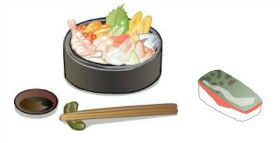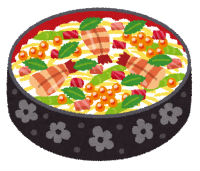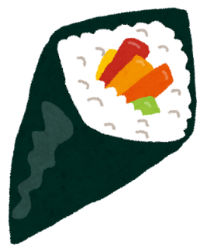Japanese washoku dishes
Japanese cuisine or Washoku was recently added to the list of the World’s Intangible Cultural Heritage. It is a cultural cuisine with differences from area to area in Japan and has a long and rich history.One of the most recognizable foods within this cuisine is of course sushi.
In this informative blog, Itaya sensei explains many of the different types of sushi. How many do you know and have tasted ? Which ones would you like to try ?
Read the blog and add a comment below !
いろいろな「寿司」
Various types of sushi

By ITAYA Sayuri
今や世界で食べられている日本料理の寿司。好きな方が多いと思います。 一言で「寿司」と言っても色々な種類があります。
皆さんがよくご存じなのは、にぎった「しゃり」(酢飯)の上に、「寿司種」や「タネ 」と呼ばれる(職人は「ネタ」というそうです) 生鮮魚介を載せた「握り寿司」だと思います。この握り寿司は握りたてを食べられる寿司屋だけでなく、寿司をのせた小皿がベルトコンベアに載って回ってくる回転寿司店、それにスーパーでも販売されているので、食べられる機会も多いと思います。
握り寿司と一緒によく食べられている「軍艦巻き」という寿司もあります。こちらは酢飯を海苔で巻き、その上に魚卵のように小さくて、形の崩れやすい寿司種を載せた寿司です。その姿が軍艦に似ていることから「軍艦巻」と名づけられたそうです。
それから酢飯とタネを海苔で細長く巻いた「巻き寿司」。太さの違いによって「細巻」や「太巻」という呼び名があります。
酢飯を味付けされた油揚げに入れる「稲荷寿司」も人気です。よくスーパーで海苔巻きとともに売られています。
他にも丼や皿に酢飯を入れ、その上に握りずしのタネを並べた「生ちらし」や酢飯とタネを重ねて力をかけて押した「押し寿司」などもあります。

また、よく家庭で作られている「ちらし寿司」。生鮮魚介だけでなく、細かく切った野菜などを酢飯に混ぜ、タネや錦糸卵などできれいに飾ります。

ホームパーティーでも簡単にできるのは「手巻き寿司」です。個人個人が海苔を持ち、その上に酢飯と好みのタネを載せて自分の手で巻いて食べます。

このように、「寿司」と言ってもとても奥が深く、たくさん種類があって、地方や家庭によっても味が異なるようです。あなたはどんな寿司を食べてみたいですか。
To listen to this blog, please watch our Youtube video.
いろいろな「寿司(すし)
今(いま)や世界(せかい)で食(た)べられている日本料理(にほんりょうり)の寿司(すし)。好(す)きな方(かた)が多(おお)いと思(おも)います。 一言(ひとこと)で「寿司」と言(い)っても色々(いろいろ)な種類(しゅるい)があります。
皆(みな)さんがよくご存(ぞん)じなのは、握(にぎ)った「しゃり」(酢飯(すめし))の上(うえ)に、「寿司種(すしだね)」や「タネ」と呼(よ)ばれる(職人(しょくにん)は「ネタ」と言うそうです) 生鮮魚介(せいせんぎょかい)を載(の)せた「握(にぎ)り寿司(ずし)」だと思(おも)います。この握り寿司は握りたてを食べられる寿司屋(すしや)だけでなく、寿司を載せた小皿(こざら)がベルトコンベアに載って回(まわ)ってくる回転寿司店(かいてんずしてん)、それにスーパーでも販売(はんばい)されているので、食べられる機会(きかい)も多いと思います。
握り寿司と一緒(いっしょ)によく食べられている「軍艦巻(ぐんかんまき)」という寿司もあります。こちらは酢飯を海苔(のり)で巻(ま)き、その上に魚卵(ぎょらん)のように小(ちいさ)さくて、形(かたち)の崩(くず)れやすい寿司種を載せた寿司です。その姿(すがた)が軍艦(ぐんかん)に似(に)ていることから「軍艦巻」と (な)づけられたそうです。
それから酢飯とタネを海苔で細長(ほそなが)く巻いた「巻(ま)き寿司(ずし」」。太(ふと)さの違(ちが)いによって「細巻(ほそまき)」や「太巻(ふとまき)」という呼(よ)び名(な)があります。
それから、酢飯を味付(あじつ)けされた油揚(あぶらあ)げに入れる「稲荷寿司(いなりずし)」も人気です。よくスーパーで海苔巻きとともに売(う)られています。
他(ほか)にも丼(どんぶり)や皿(さら)に酢飯を入れ、その上に握り寿司のタネを並(なら)べた「生(なま)ちらし」や酢飯とタネを重(かさ)ねて力(ちから)をかけて押(お)した「押(お)し寿司(ずし)」などもあります。
また、よく家庭(かてい)で作(つく)られている「ちらし寿司(ずし)」。生鮮魚介だけでなく、細(こま)かく切(き)った野菜(やさい)などを酢飯に混(ま)ぜ、タネや錦糸卵(きんしたまご)などできれいに飾(かざ)ります。
ホームパーティーでも簡単(かんたん)にできるのは「手巻(てま)き寿司(ずし)」です。個人個人(こじんこじん)が海苔を持(も)ち、その上に酢飯と好(この)みのタネを載せて自分(じぶん)の手(て)で巻いて食べます。
このように、「寿司」と言っても、とても奥(おく)が深(ふか)く、たくさん種類(しゅるい)があって、地方(ちほう)や家庭(かてい)によっても味(あじ)が異(こと)なるようです。あなたはどんな寿司を食べてみたいですか。
Various types of sushi
Right now at this time, one Japanese cuisine is being eaten all around the world, and this is sushi. I think there are a lot of people who love this food.
Although we use the one word 'sushi', there are actually a lot of different varieties. I think that the one you are most familiar with is Nigiri zushi, which is the one with the hand-formed sushi rice (or shari) on top of which the sushi topping (or tane - which is also called neta by craftsmen) of fresh seafood is placed. This Nigiri zushi can be eaten not only at sushi bars, but also it can be found placed on plates which revolve along conveyor belts at Kaiten Sushi shops and also sold in supermarkets, so you have many opportunities to eat this type of sushi.
Also often eaten with Nigiri zushi is the Gunkan Maki type of sushi. This consists of sushi rice which is wrapped with Nori seaweed and on top of this, sushi toppings which are small and crumble easily, like fish roe, are placed. The shape resembles a battleship (or Gunkan in Japanese ) so it was named Gunkan Maki.
There is also Maki zushi in which the sushi rice and the sushi topping are rolled length-ways in some Nori seaweed. Depending on the thickness, they also go by the names Hosomaki (thin rolls) and Futomaki (thick rolls).
Also Inari zushi is popular too, which is seasoned fried tofu into which sushi rice is inserted. In the supermarkets these are often sold along side the Nori seaweed rolls.
Other types are Nama chirashi in which the sushi rice is put on a plate or in a bowl and sushi toppings are placed on top, or Oshi zushi in which the rice and sushi topping are layered on top of each other in a bowl or on a plate and pushed down on very hard.
And there is Chirashi zushi which is often made at home. This type uses not only seafood ingredients but also thinly sliced vegetables mixed in the sushi rice and decorated with thin-cut omelette strips and sushi toppings on top.
Temaki zushi can be easily made for home parties. Each person takes a piece of Nori seaweed and places some sushi rice on it then selects a piece of sushi topping of their choice and wraps it with their own hands and eats it.
So in this way, when we say 'sushi' we refer to a very profound food with many varieties and with tastes that differ from area to area and from family to family. Which sushi would you like to try ?
今や 【いまや】 now (esp. in contrast to the past); now at last; at present; right now
酢飯 【すめし】 {food} vinegared rice; rice prepared for sushi
種 【たね】 {food} ingredient; leaven (bread); main ingredient of a sushi
職人 【しょくにん】 worker; mechanic; artisan; craftsman
生鮮 【せいせん】 fresh
魚介【ぎょかい】 marine products; seafood; fish and shellfish
載せる 【のせる】to place on (something)
握り寿司 【にぎりずし】{food} nigirizushi; hand-formed sushi with a topping of seafood, etc.
【たて】 just (done); freshly (baked); indicates activity only just occurred
ベルトコンベアconveyor belt; belt conveyor;
回転寿司 【かいてんずし】"conveyor belt" sushi bar; sushi-go-round; sushi train; kaiten-zushi
販売 【はんばい】 sales; selling; marketing
機会 【きかい】 chance; opportunity
軍艦巻 【ぐんかんまき】 battleship roll sushi
のり; ノリ 《海苔》 nori (edible seaweed, esp. species Porphyra tenera and others of genus Porphyra, usu. dried and pressed into sheets); laver
巻く 【まく】 to roll
魚卵 【ぎょらん】 fish eggs; roe
崩れる 【くずれる】 to collapse; to crumble; to get out of shape; to lose one's shape
姿 【すがた】 figure; form; shape
軍艦 【ぐんかん】 warship; battleship
似る 【にる】 to resemble; to look like; to take after
名づける 【なづける】 to name; to call
細長い 【ほそながい】 long and narrow
呼び名 【よびな】 given name; popular name
味付け 【あじつけ】{food} seasoning; flavour; flavor
油揚げ 【あぶらあげ】 {food} fried tofu
稲荷寿司 【いなりずし】 {food} sushi wrapped in fried tofu
とともに 《と共に》 together with
重ねる 【かさねる】 to pile up; to put something on top of another;
押し寿司 【おしずし】 {food} oshizushi; sushi rice and other ingredients pressed in box or mould (mold)
錦糸卵 【きんしたまご】 thin omelette cut into strips
飾る 【かざる】 to decorate
手巻き寿司 【てまきずし】 {food} hand-rolled sushi (usu. cone-shaped)
個人個人 【こじんこじん】 individual; one by one
好み 【このみ】 liking; taste; choice
によって異なる 【によってことなる】 to differ depending on ...
奥が深い【おくがふかい】profound
Hajimemashite, everyone. My name is Itaya Sayuri. I live in Sapporo, Hokkaido.
Sapporo is a really liveable city because, although we have a lot of snow in the winter, the summers are much cooler than other areas of Japan. Apart from teaching Japanese, I also hope to let everyone know about Sapporo, its beautiful nature and delicious food.
I play volleyball once or twice a week for my health and play golf on occasion. I also love watching movies.
Do you think the Japanese language is difficult? Well, come and enjoy studying with me in our online Japanese classroom?don't worry about making mistakes and just try to speak up as much as possible. I think this is the secret to success in Japanese. Ganbare!




